What are Clean Fuels and How Clean Can They Get

In Oregon the Department of Environmental Quality (DEQ) catalogues all fuels that involve carbon emission in fuel production and those that do not. Every fuel sold in Oregon is audited for Well to Tank (WTT) carbon emissions.
Because emissions of the damaging pollutant carbon dioxide (CO2) during production have already occurred, and are unique to each fuel type, upstream fuel emissions serve as a metric for preferred fuels that involve the least carbon emissions.
This table lists each fuel type and the amount of CO2 (in grams) needed to produce and deliver a given standard amount of energy for each (measured in Joules, and noted in MegaJoules – MJ). The unique parameter for each fuel depends on the carbon emitted in the production cycle and is termed “Carbon Intensity” – more carbon consumed upstream means a higher “CI” number for its intensity.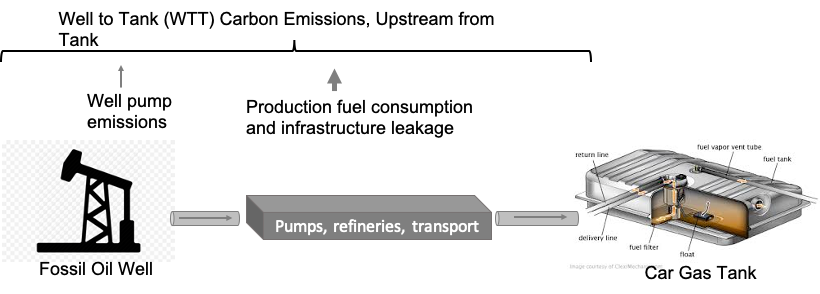
| Which Fuels in Oregon are Clean? | Typical Carbon Intensity GCO2e/MG | |
|---|---|---|
| 1 | Biodiesel | 14-59 |
| 2 | Compressed Natural Gas | |
| 3 | Ethanol | 22-79 |
| 4 | Renewable Diesel | 15-101 |
| 5 | Hydrogen | 0-151 |
| 6 | Liquified Natural Gas | 37-63 |
| 7 | Electricity | 0-135 |
| 8 | Gasoline | 100 |
| 9 | E10 Gasoline | 96-98 |
| 10 | Liquified Petroleum Gas | 81 |
| 11 | Renewable Propane | 39 |
| 12 | Renewable Diesel | 17-101 |
| 13 | Diesel | 101 |
| 14 | B5 Diesel | 96-98 |
| 15 | B20 Diesel | 80-84 |
| Lowest CI Factors indicate preferred Clean Fuels | ||
In the case of Electricity, the generation path can be from a coal plant, an oil plant, a natural gas plant, from wind or solar or a geothermal generator. The coal pathway would be characterized with a high end CI (=135), while solar/wind/geo would be rated close to zero, like hydro power generation.
Under the terms of the DEQ Clean Fuel Program (CFP) the source of each fuel is important. Incentives are made available for fuels with a lower CI factor. In general, when the refining process emits serious amounts of CO2, plus significant amounts of CO2 for transportation, the assigned CI characteristic can be a very high number.
DEQ catalogues the CI of each fuel by computing from its unique supply pathway. This table lists typical pathways for carbon fuels.
Physical Pathways for the Oregon Clean Fuels Program
(as of February 11,2016)
| Physical Pathway Code | Physical Pathway Description | |
|---|---|---|
| PHY00 | Not Applicable | |
| PHY01 | Fuel produced in Oregon | |
| PHY02 | By rail from US to Oregon | |
| PHY03 | By ocean tanker from Brazil to US, then by rail to Oregon | |
| PHY04 | By ocean tanker from Brazil to Caribbean Islands, and by ocean tanker to US, then by rail to Oregon | |
| PHY05 | By ocean tanker from Malaysia to US, then by rail to Oregon | |
| PHY06 | By ocean tanker from Indonesia to US, then by rail to Oregon | |
| PHY07 | By ocean tanker from other country to US, then by rail to Oregon | |
| PHY08 |
| |
| PHY09 | By ocean tanker to Oregon | |
| PHY10 | New Pathway to be Established | |
| PHY11 | By ocean tanker from Brazil to Caribbean Islands, ocean tanker to Oregon | |
| PHY12 | By pipeline from North America to Oregon | |
| PHY13 | By ocean tanker from Brazil through the Panama Canal to Oregon | |
| PHY14 | EV charging and/or electricity supplied for transportation to Oregon | |
| PHY15 | By rail from Canada to Oregon | |
| PHY16 |
| |
| PHY17 | By truck from Canada to Oregon | |
| PHY18 | Fuel produced in US and barged to Oregon | |
| PHY19 | By barge from Canada to Oregon |
A more up-to-date table listing all catalogued fuels and their pathways can be found at this DEQ link.
For example, PHY14 electricity supplied from wind or solar would earn a near zero CI factor.
Biofuels
The crop feedstocks for biofuels capture carbon, and biofuels can be blended with fossil fuels.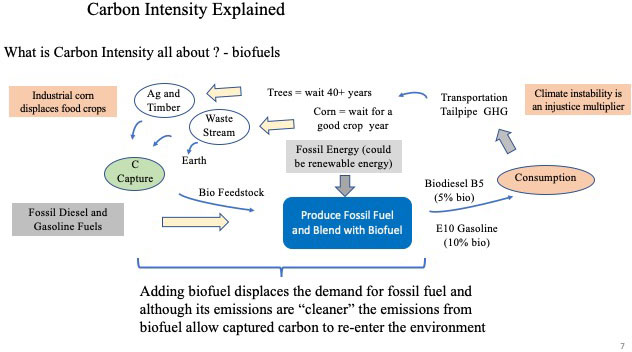
Biofuels have advantages when blended with fossil fuels. The feedstock for the blend captures carbon, which reduces the total carbon of the biofuel pathway, and the fuel blend displaces the supply from exclusively fossil fuel sources. Anaerobic digesters emit methane (way worse for climate than CO2), so capturing methane (CH4) and processing it as a biofuel (renewable natural gas) is a proven way to limit climate damage.
Displacement of food crops is disadvantage, and the consumption of biofuels returns sequestered carbon to the environment which continues to destabilize climate, an instability that multiplies economic and equity injustice. Even renewable natural gas returns captured carbon to the environment at a time when permanently capturing carbon is the only way to attain carbon neutrality.
Carbon-Free Fuels
Although biofuels can be posed as renewable energy sources, their Carbon Intensity potential is more limited than wind and solar for example. 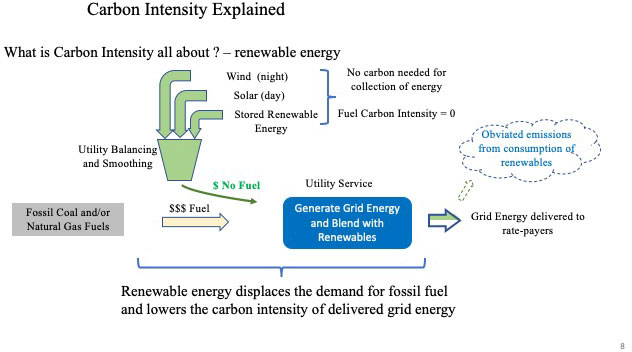 These latter renewables are free of physical commodity handling infrastructure (fuel storage, pipelines, pumps, refining, compressors and their maintenance costs), establishing a cost advantage while connecting directly to the energy grid.
These latter renewables are free of physical commodity handling infrastructure (fuel storage, pipelines, pumps, refining, compressors and their maintenance costs), establishing a cost advantage while connecting directly to the energy grid.
Oregon DEQ has set an annual standard for Carbon Intensity that increases the availability of incentives for lower and lower CI fuels. It is currently (2020) set to decline 1% annually, and 2% in 2025.
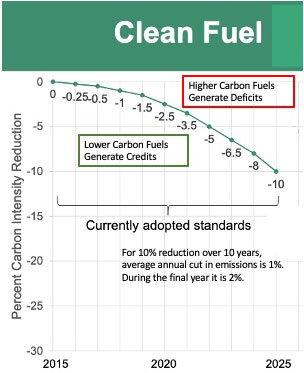 Carbon fuels with a CI rating that is reduced year on year to below the curve are the “Clean” fuels. Those without CI reduction are still termed “Clean” since their supplier has purchased offsets to put them below the curve in terms of bookkeeping, regardless of being less clean in terms of chemistry.
Carbon fuels with a CI rating that is reduced year on year to below the curve are the “Clean” fuels. Those without CI reduction are still termed “Clean” since their supplier has purchased offsets to put them below the curve in terms of bookkeeping, regardless of being less clean in terms of chemistry.
As a consequence, the Clean Fuels with lower CI have avoided the need to purchase carbon offsets and so are more affordable.
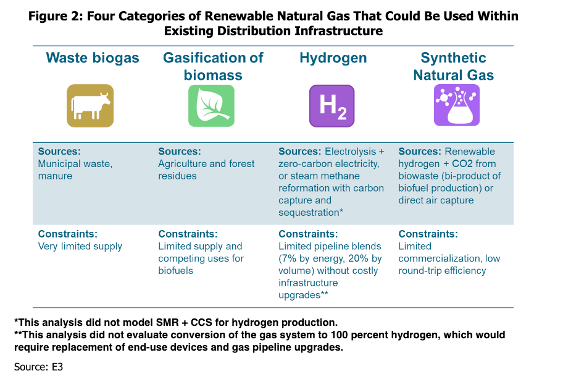 The economic advantages of wind and solar over other renewables like renewable natural gas have been studied at length.
The economic advantages of wind and solar over other renewables like renewable natural gas have been studied at length.
An important economic scenario is one that maximizes the climate relief offered renewable energy (zero CI).
As coal generation declines in 2030 (in accordance with 2016 SB 1547) and bio-fuels are feedstock limited, the clean fuels standard can be extended. Under the GHG EO 20-04 the Clean Fuels Program is directed for expansion beyond 2025, “reducing the average amount of GHG emissions per unit of fuel energy by 20 percent below 2015 levels by 2030, and 25 percent below 2015 levels by 2035.”
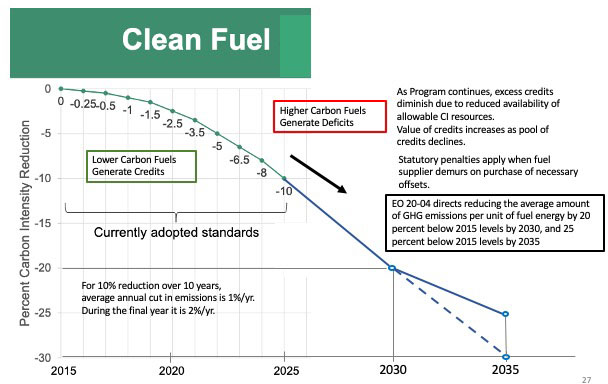 Due to the urgency of climate action, the GHG EO should be amended to attain 30 percent below 2015 CI ratings by 2030.
Due to the urgency of climate action, the GHG EO should be amended to attain 30 percent below 2015 CI ratings by 2030.
The benefit of reducing the average CI for Oregon fuels is not just theoretical. The CFP can and will reduce mass carbon in Oregon as the polluting pathways decline, but more significantly as the more affordable zero-CI fuels dominate consumption. Although the mass carbon reductions gained by the CFP can be computed, this has not been standardized by DEQ or by the GHG EO. Once this is accomplished, the benefit of the CFP for ODOT mass carbon reduction goals can be known.
Rulemaking directed by Oregon Greenhouse Gas EO 20-04
Proposed rules must conform to the Rules for the Rules. Neither the CFP Rules Advisory Committee (RAC) nor the public can participate effectively in rulemaking without disclosure of the Rules for the Rules.
Recommended Rules
- Each fuel species shall be evaluated by fixed standards and recorded with a corresponding CI factor.
- The domain for Carbon Intensity is all positive integers.
- Additionality is precluded. Since the CFP is designed to reduce emitted carbon, proliferation of anaerobic methane generation shall not be incented by allowing CFP offsets or credits for captured methane. Ref: https://www.offsetguide.org/high-quality-offsets/additionality/
[Incentives for anaerobic methane capture are appropriate under Cap and Reduce rules] - 4. Emission segment carbon attributes for pathway assessment shall be standardized in rules language.
- An algebraic formula to determine the annual mass carbon emissions equivalent to the CFP avoided emissions shall be included in rulemaking.
